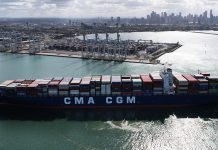
Container movements at the Port of Barcelona reached 3.3 million TEUs in 2023, marking a 7% decline compared to the previous year.
The decrease was primarily driven by a significant drop in transits (-20%), which are influenced by the strategic decisions of shipping companies.
Additionally, exports (-12%) experienced declines across various sectors including chemicals, capital goods, food and feed, and various manufactured products. However, imports remained nearly unchanged from 2022 (-1%), while cabotage saw a notable 18% increase by the end of the year.
China, United States and Turkey emerged as the Port of Barcelona’s primary trading partners for containerized goods, holding market shares of 26.7%, 5.8%, and 4.9%, respectively.
However, hinterland traffic, which comprises export and import goods entering and leaving the Port of Barcelona (excluding tare weights or transits), showed a more favourable performance, totalling 33.7 million tonnes with a decrease of 4.3%. This was partly due to declines in traffic segments with lower added value and less positive impact on the local economy, such as containers and liquid bulk.
“The Port of Barcelona handled 64 million tonnes of goods traffic during the last year, down 9.8%. As a result of a complex international context, with an increasing number of geopolitical conflicts, low European demand and a significant cooling down of exports, in addition to the unfavourable comparison with 2022, during which we broke traffic records,” stated José Alberto Carbonell, general manager of the institution.
Furthermore, in the fiscal year 2023, the Port of Barcelona achieved a turnover of US$204 million, marking a growth of 4.4% and surpassing the previous record of US$195 million set in 2022. However, despite the rise in turnover, the Port of Barcelona experienced a decrease in operating income, which amounted to US$47.5 million, down by 18.5% compared to the previous year.
This decline can be attributed to increased expenditures, notably in operational aspects such as increased spending on infrastructure maintenance and computer systems. Additionally, there were elevated expenses in the personnel sector, taking into account agreed-upon arrears and salary increases for public administration employees.
Moreover, the costs associated with the implementation of the agreement with Barcelona City Council to centralize cruise terminals on Adossat wharf contributed to this financial chapter.
“These positive economic figures protect us from the effects of the macroeconomic and geopolitical situation of recent months and place us in an unbeatable position to carry out the major projects that the Port will be undertaking in coming years, which will surely require significant policies and financial actions,” said Miriam Alaminos, deputy general manager of Finance and Economics at the Port of Barcelona in her speech.
As she reviewed the economic figures, Miriam Alaminos recalled that “the Port of Barcelona continues to be the principal contributor to the general system of State Ports via the various solidarity instruments provided for in the Ports Law, contributing 4% of the income received in fees to finance the State Ports body Puertos del Estado; 4% of its cashflow for the Interport Solidarity Fund and 1% of its cashflow to finance the Ports 4.0 fund.”
Involving 16 participating companies alongside the CARES Foundation, which is represented by CILSA, the Port of Barcelona Corporation recorded a combined turnover of US$372 million in 2023. The total workforce across all these entities amounted to 1,481 employees.





